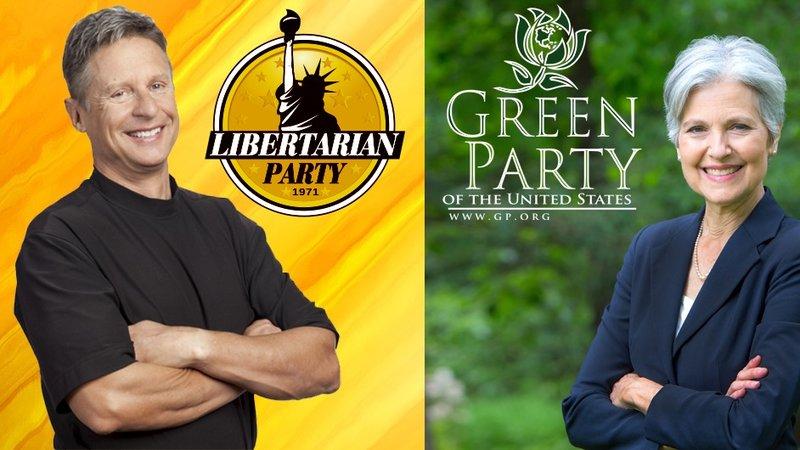Libertarian Gary Johnson and The Green Party’s Jill Stein are energy idealists.
The 2016 presidential campaign won’t be over soon enough for most Americans. With Democrat Hillary Clinton and Republican Donald Trump both tipping all-time low approval ratings (an August CBS News poll had Trump’s favorability rating at 36 percent among U.S. voters; Clinton’s was at 46 percent) a lot of American voters are giving the lesser-known party candidates a look. With at least 27 declared candidates for president, not all independent and 3rd party candidates are experiencing a boost, but the two nationally competitive 3rd parties, the Libertarian Party and the Green Party, are garnering record levels of support during this election cycle. How do they stack up to Trump and Clinton on solar policy?
Libertarian Gary Johnson is a former Republican governor of the state of New Mexico, although his executive track record on solar policy is pretty sketchy. He was governor until 2003, so the solar boom happened several years after his retirement from office. Dr. Jill Stein, the Green Party candidate, is a well-respected physician and environmental activist. Never having served in political office, her positions on solar are more based on the Green Party platform and her efforts to forward anti-fossil fuel legislation in the Massachusetts legislature.
Dr. Stein’s 2016 platform features a “Power to the People” energy plan which includes the following:
“Enact an emergency Green New Deal to turn the tide on climate change, revive the economy and make wars for oil obsolete. Initiate a WWII-scale national mobilization to halt climate change, the greatest threat to humanity in our history. Create 20 million jobs by transitioning to 100% clean renewable energy by 2030, and investing in public transit, sustainable agriculture, conservation and restoration of critical infrastructure, including ecosystems.”
Wow, I guess you don’t get much more pro-solar than that! Of course, the devil is in the details, but the details of the Stein plan are equally ambitious:
- Enact energy democracy based on public, community and worker ownership of our energy system. Treat
 energy as a human right.
energy as a human right. - Redirect research funds from fossil fuels into renewable energy and conservation. Build a nationwide smart electricity grid that can pool and store power from a diversity of renewable sources, giving the nation clean, democratically-controlled, energy.
- End destructive energy extraction and associated infrastructure: fracking, tar sands, offshore drilling, oil trains, mountaintop removal, natural gas pipelines, and uranium mines. Halt any investment in fossil fuel infrastructure, including natural gas, and phase out all fossil fuel power plants. Phase out nuclear power and end nuclear subsidies. End all subsidies for fossil fuels and impose a greenhouse gas fee / tax to charge polluters for the damage they have created.
The Libertarian Party’s 2016 platform is far less specific about their stand on energy, but even in its brevity, it couldn’t be more different than the Green Party’s goals:
While energy is needed to fuel a modern society, government should not be subsidizing any particular form of energy. We oppose all government control of energy pricing, allocation, and production.
However, Gary Johnson has expressed a considerably more nuanced stand on the issue of renewable energy vs. fossil fuel. Johnson talked energy policy with the Juneau Empire, explaining that “I do believe that climate change is occurring. I do believe that it is man-caused.”
To address climate change, Johnson said he believes “…there can be and is a free-market approach to climate change.”

That would include a fee — not a tax, he said — placed on carbon. Such a fee would make pollutants bear a market cost.
“We as human beings want to see carbon emissions reduced significantly,” but at the same time, he says the United States is only “16 percent of the (global) load” of carbon, and “I don’t want to do anything that harms jobs.”
Mr. Johnson is obviously playing semantic games. Miriam Webster defines a tax as:
- a : a charge usually of money imposed by authority on persons or property for public purposes
- b : a sum levied on members of an organization to defray expenses
The Libertarian platform does not explicitly oppose all taxes, but Johnson knows that a carbon tax is a non-starter for many libertarian and republican voters. He is trying to walk a fine line, but ultimately, he can’t win on this issue. His party platform calls for an end to subsidies and complete deregulation of the utility industry. When all’s said and done, solar would be the obvious winning technology in such a scenario, but only after complete grid system collapse. Johnson certainly doesn’t want to be president in a Mad Max-ian dystopia. Instead, he is talking baby steps.
In many ways, the Libertarian vs. Green approach to the energy debate is simply a distillation of the core ideological dispute between the Democrats and Republicans. Government programs vs. the free market. Although both plans look good on paper, new technologies simply cannot be expected to compete against government sanctioned monopolies. Neither can new subsidies piled on top of old subsidies have the desired leveling effect without unintended consequences.
Bottom line: As a solar advocate, should you vote for a 3rd party candidate? I certainly don’t expect Stein or Johnson to win in this election, but if you live in a state that is not a swing state, this may be your best opportunity to cast a vote for your ideals, be those Free Market or New Deal.






